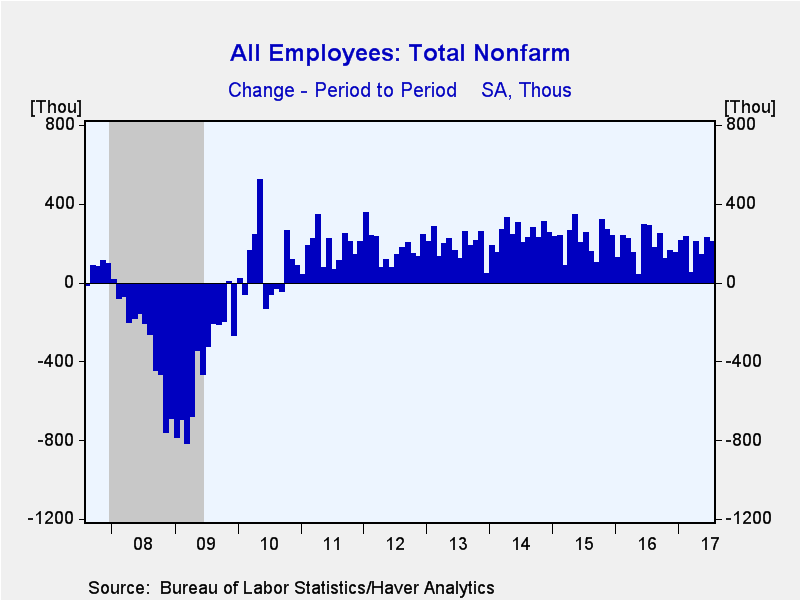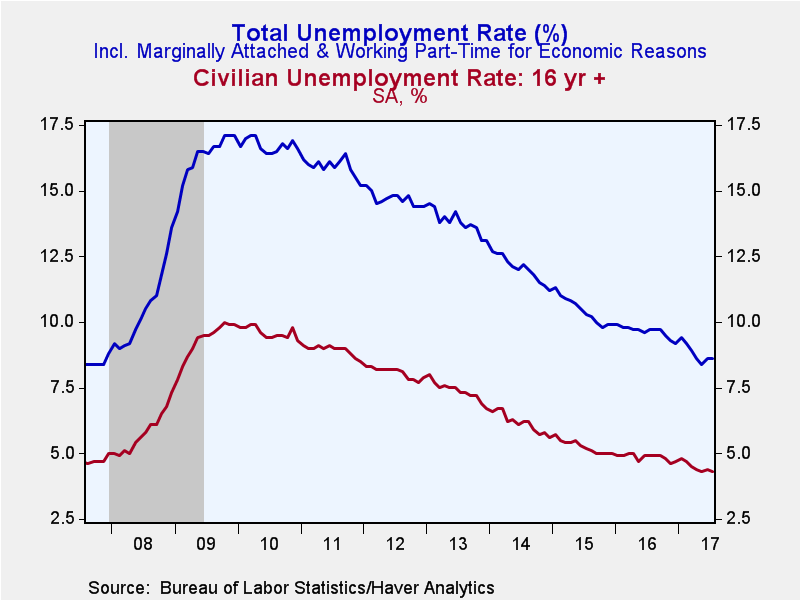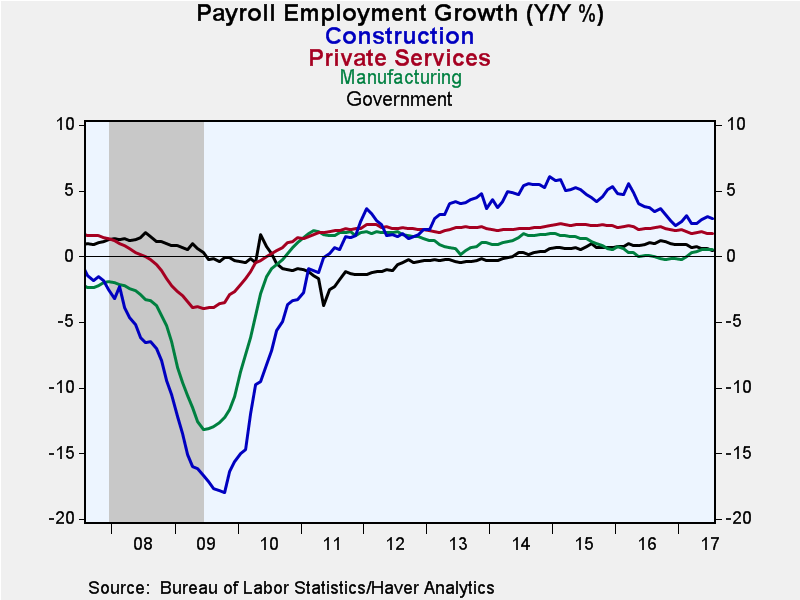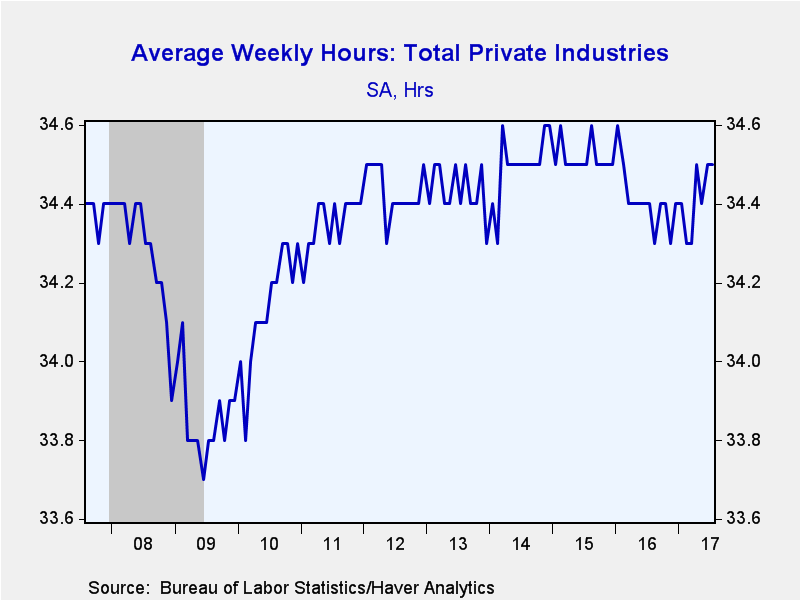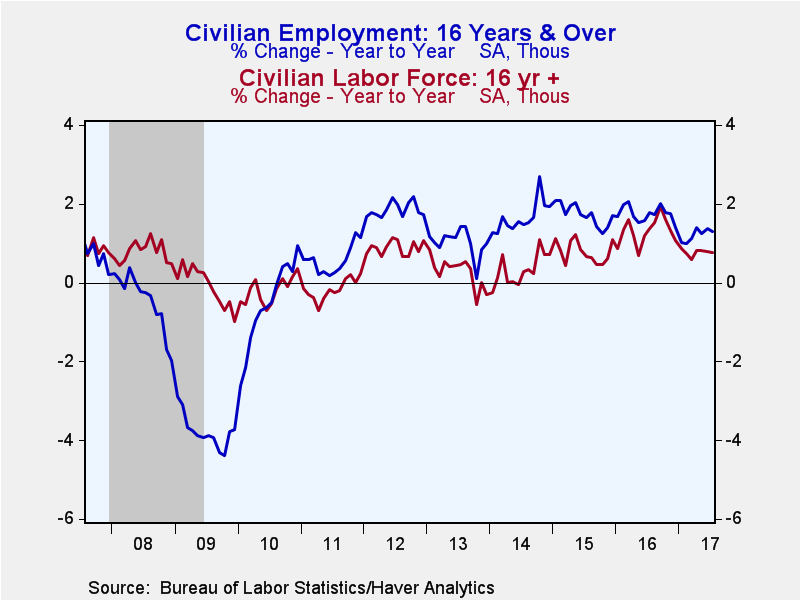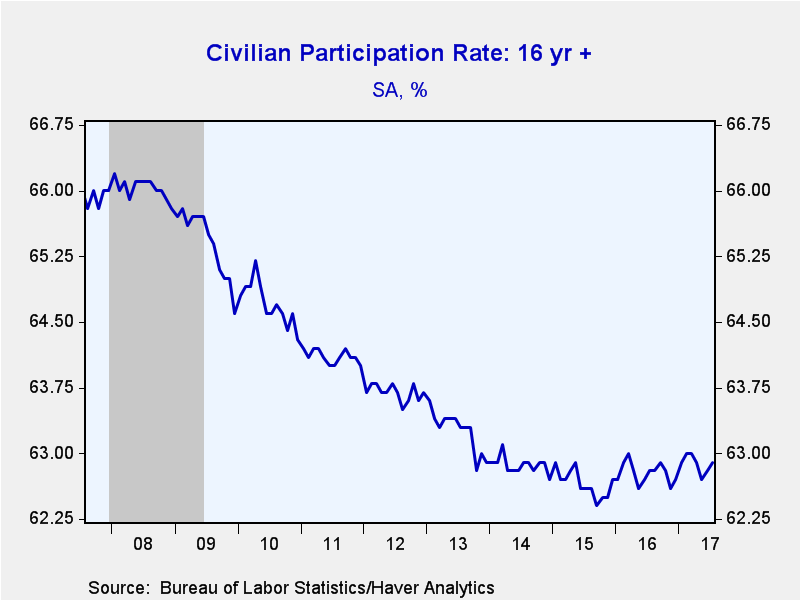 Global| Aug 04 2017
Global| Aug 04 2017U.S. Payroll Increase Moderates and Unemployment Rate Slips
by:Tom Moeller
|in:Economy in Brief
Summary
Nonfarm payrolls rose 209,000 (1.5% y/y) during July. A 181,000 increase had been expected in the Action Economics Forecast Survey. The rise followed gains of 231,000 in June and 145,000 in May. Together these figures were revised up [...]
Nonfarm payrolls rose 209,000 (1.5% y/y) during July. A 181,000 increase had been expected in the Action Economics Forecast Survey. The rise followed gains of 231,000 in June and 145,000 in May. Together these figures were revised up by 2,000. Hiring activity was mixed amongst sectors. Average hourly earnings rose an expected 0.3% (2.5% y/y) following 0.2% gains during the prior two months. The unemployment rate eased to 4.3%, as expected, and reversed June's uptick. The overall unemployment rate, including marginally attached workers and those working part-time for economic reasons, held steady at 8.6%.
From the payroll employment survey, private sector payrolls increased 205,000 (1.7% y/y), the strongest increase since February. Factory sector hiring rose 16,000 (0.5% y/y), also a five month high. Construction sector jobs gained a diminished 6,000 (2.8% y/y). Double-digit increases per month were common late last year through February. Mining sector employment rose 1,200 (8.4% y/y), the weakest increase since the number of jobs began to rise in November.
Private service sector employment increased 183,000 (1.7% y/y), the strongest increase since last September. Leisure & hospitality employment strengthened 62,000 (2.1% y/y), the strongest increase since September 2015 and up from a monthly increase of just 5,000 in December. Education & health care sector jobs increased 54,000 (2.3% y/y). They were driven by a 45,000 increase (2.1% y/y) in health care, the strongest gain in a year. Professional & business service sector jobs improved a fairly steady 49,000 (2.9% y/y). The 14,700 increase (4.3% y/y) in the number of temporary help jobs also was in line with this year's gains. Trade, transportation & utilities jobs grew a modest 7,000 (0.5% y/y), including a 900 uptick (-0.1% y/y) in retail hiring. Financial activities employment improved 6,000 (1.8% y/y) while information sector jobs increased 4,000 (-1.7% y/y).
Government sector jobs rose just 4,000 (0.5% y/y) after a 37,000 jump. Local government employment increased 7,000 (0.7% y/y) but the number of federal government jobs remained unchanged (0.3% y/y). State government employment eased 3,000 (+0.1% y/y).
The length of the average workweek held steady at 34.5 hours, but that was up from 34.3 hours early this year. Individuals in the financial sector worked a slightly lessened 37.5 hours. In the information sector, individuals worked a stable 36.3 hours, up from last year's low of 35.8 hours. Education & health services hours also were stable m/m at 32.9, but up from the low of 32.6 in mid-2014. Leisure & hospitality hours-worked held steady at 26.1.
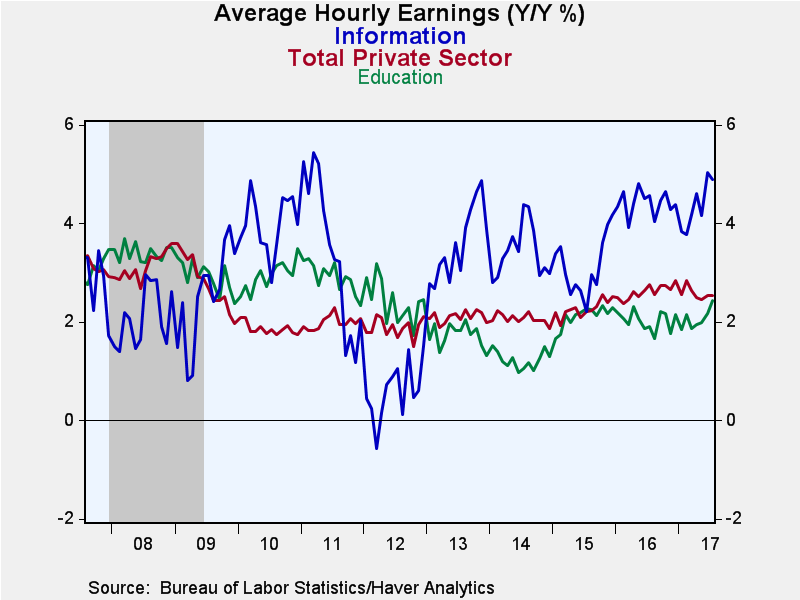 Average hourly earnings improved 0.3%, the largest monthly
increase since October. The y/y increase of 2.5% remained down, however, from
the 2.9% high as of December. Information sector earnings strengthened 4.9% y/y
while leisure & hospitality earnings improved 3.8% y/y, up from little
change in 2010. Factory sector earnings grew a diminished 2.6% y/y while
construction pay gained a steady 2.4% y/y. Education & health services
earnings grew an accelerated 2.4% y/y; retail trade earnings gained a steady 1.6% y/y.
Average hourly earnings improved 0.3%, the largest monthly
increase since October. The y/y increase of 2.5% remained down, however, from
the 2.9% high as of December. Information sector earnings strengthened 4.9% y/y
while leisure & hospitality earnings improved 3.8% y/y, up from little
change in 2010. Factory sector earnings grew a diminished 2.6% y/y while
construction pay gained a steady 2.4% y/y. Education & health services
earnings grew an accelerated 2.4% y/y; retail trade earnings gained a steady 1.6% y/y.
From the household employment survey, the dip in the unemployment rate to 4.3% brought it to the lowest level since May 2001. Employment grew 345,000 (1.3% y/y) while the labor force increased 349,000 (0.8% y/y). The labor force participation rate rose to 62.9%, its highest level in three months. That was down, however, from 66.2% in 2006. The size of the population grew 0.6% y/y. The number of individuals not in the labor force grew 0.4% y/y, down from 0.7% growth during all of last year and the roughly 2% to 3% growth rates from 2009 to 2015.
The average duration of unemployment rose slightly m/m to 24.9 weeks. It was down, however, from 28.0 weeks one year earlier and from 39.4 weeks during all of 2011. The number of long-term unemployed, 27 weeks or more, declined 11.5% y/y.
By educational attainment, individuals with less than a high school diploma realized a slightly higher 6.9% jobless rate as employment fell 1.2% y/y. Those with a high school diploma saw 4.5% joblessness as employment improved 0.7% y/y. Unemployment for individuals with less than a bachelors degree was 3.7% as employment eased 0.5% y/y. Unemployment of just 2.4% was realized for those with a bachelors degree as employment jumped 3.2% y/y.
The teenage unemployment rate of 13.2% reflected 2.3% y/y growth in jobs. Individuals aged 20 to 24 years were 7.4% unemployed as employment grew 2.3% y/y. Those aged 25 and over saw jobs growth of 1.2% y/y produce a 3.8% unemployment rate.
The labor market data are contained in Haver's USECON database. Detailed figures are in the EMPL and LABOR databases. The expectations figure is in the AS1REPNA database.
| Employment: (SA, M/M Change, 000s) | Jul | Jun | May | Jul Y/Y | 2016 | 2015 | 2014 |
|---|---|---|---|---|---|---|---|
| Payroll Employment | 209 | 231 | 145 | 1.5% | 1.7% | 2.1% | 1.9% |
| Previous | -- | 222 | 152 | -- | -- | -- | -- |
| Manufacturing | 16 | 12 | 0 | 0.5 | 0.1 | 1.2 | 1.4 |
| Construction | 6 | 15 | 7 | 2.8 | 3.9 | 5.0 | 5.0 |
| Private Service-Producing | 183 | 162 | 140 | 1.7 | 2.1 | 2.4 | 2.1 |
| Government | 4 | 37 | -8 | 0.5 | 0.9 | 0.7 | 0.1 |
| Average Weekly Hours - Private Sector | 34.5 | 34.5 | 34.4 | 34.4 | 34.4 | 34.5 | 34.5 |
| Private Sector Average Hourly Earnings (%) | 0.3 | 0.2 | 0.2 | 2.5 | 2.6 | 2.3 | 2.1 |
| Unemployment Rate (%) | 4.3 | 4.4 | 4.3 | 4.9 | 4.8 | 5.3 | 6.2 |
Tom Moeller
AuthorMore in Author Profile »Prior to joining Haver Analytics in 2000, Mr. Moeller worked as the Economist at Chancellor Capital Management from 1985 to 1999. There, he developed comprehensive economic forecasts and interpreted economic data for equity and fixed income portfolio managers. Also at Chancellor, Mr. Moeller worked as an equity analyst and was responsible for researching and rating companies in the economically sensitive automobile and housing industries for investment in Chancellor’s equity portfolio. Prior to joining Chancellor, Mr. Moeller was an Economist at Citibank from 1979 to 1984. He also analyzed pricing behavior in the metals industry for the Council on Wage and Price Stability in Washington, D.C. In 1999, Mr. Moeller received the award for most accurate forecast from the Forecasters' Club of New York. From 1990 to 1992 he was President of the New York Association for Business Economists. Mr. Moeller earned an M.B.A. in Finance from Fordham University, where he graduated in 1987. He holds a Bachelor of Arts in Economics from George Washington University.


